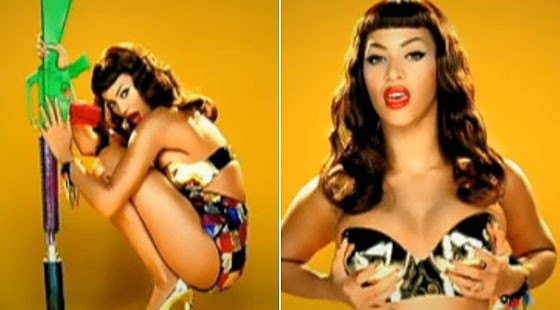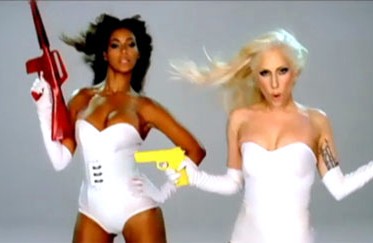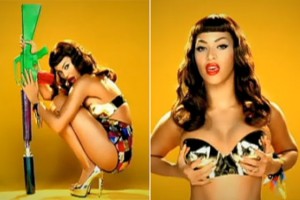
Some thoughts on Spring Breakers, Beyonce, Resilience, and Race
I just watched Harmony Korine’s Spring Breakers last night (I know, I know, so so so late to this party). There’s already been a ton of great criticism written about the film, but here I want to think about it in relation to Beyonce & Lady Gaga’s pair of “Phone” videos–“Video Phone” & “Telephone”–and, sort of obliquely, my TNI article on Rihanna, resilience, & race.
Like these videos, the film climaxes, both sonically/musically and narratively, when nearly-naked young cis-women execute a stereotypically thuggish black man. In “Telephone,” Bey and Gaga’s cross-racial feminist alliance is cemented when they kill Bey’s abusive, misogynist ex-boyfriend. In “Video Phone,” Bey and Gaga execute the male gaze, here represented as a chorus of dark-skinned male bodies with cameras for heads. In the film, the two most hardcore white protagonists execute the gangsta boss played by Gucci Mane–notably, while he is wearing bling in a hottub, watching two black women (perhaps in his employ as strippers?) perform for him across the room. They also execute all of his henchmen.
In all three music videos (because that’s more or less what Spring Breakers is, right, VJ mix for a DJ mix, or a VJ mix held together by the underlying sounds), women overcome the damage of “the male gaze” by killing the men who are deemed most responsible/culpable for it–non-bourgeois black men. Rappers have long been white supremacist patriarchy’s scapegoats; concerns about the excessive misogyny in rap are often racist ploys to scapegoat black men, making them seem responsible for the misogyny that is actually a central feature of white supremacy, too. These videos update this trope. Non-bourgeois black men must be eliminated by female characters so that dominant society can prove it is both post-racial (they’re bad because they’re misogynist, not because they’re black) and post-feminist (look at these women conquer misogyny (which is limited only to this “primitive,” backwards subgroup)! patriarchy is over). White and non-white women saving themselves from black men. But notice what drops out of this remix of Spivak’s famous formulation, “white men saving brown women from brown men”: white men, white patriarchy. It doesn’t have to be an explicit term of control because neoliberal white patriarchy works as a deregulatory mechanism, controlling the background conditions, not the foreground action. Also, WOC-as-victim falls out of this remixed formulation. In multi-racial white supremacist patriarchy, all women are resilient. Resilient women is what distinguishes normal, post-feminist societies from “backwards” ones in need of rescue by “white saviors.”
Just think about the (miniscule) presence of black women in Spring Breakers. As Ayesha Siddiqi argues in her fabulous “Bikini, Kill”: If Spring Breakers showcases the thrill of reclaiming patriarchy’s sexualization, then it’s an agency extended only to white girls. In contrast to [black man] Archie’s rule over the black women around them, [white man] Alien simply serves to reflect the four leads’ electric force.” The film presents phenotypically and culturally “white” women’s bodies in the same manner that black women’s bodies are commonly featured in hip hop videos: jiggly jelly, lots of ass shots, bikini-clad dancing, partying, and so on. There are a few black women presented among the spring-breaking throngs of college students (i.e., as members of MRWaSP cultural whiteness), but mainly black women appear as sex workers. So, they’re shot in similar ways to the white women, in similar states of undress and sexualization, but unlike the white women, who are commonly read as in control of their sexuality, the black women’s sexualized bodies are presented as alienated labor. Thus, unlike the resilient white women, these black women are victims in need of saving–by resilient white women. And that’s exactly what happens in the bathroom scene when the two white female protagonists kill Archie; they save two black women from his male gaze.
This scene isn’t that different than “Video Phone.” Here, Beyonce, in various states of swimwear-undress, demonstrates her overcoming of traditional male-gaze style objectification by executing a stereotypically thuggish black man.
I’ve already discussed how the video visually presents the male gazer as a man of color. The lyrics reaffirm this, and, with references both to his verbal dialect and his sartorial style, specify him as a member of working-class, urban black culture. The song begins with Beyonce saying “Shawty, whatchyo name is.” Here, she’s momentarily performing a bit of vocal drag, adopting the persona of the male gazer. This phrase is his hail or catcall to Beyonce’s character, his attempt to fix her as the object of his gaze. (She responds by undermining this hail: you can’t look at me, but you can put me on your video phone. This demand to move from traditional gazing, with its clear subject/object dichotomy, to video-phone style prosumer consumption/production, is how Beyonce both overcomes “the male gaze” and asserts her resilience–she’s no mere object, but a prosuming entrepreneur.) Then, later, Beyonce’s narrator describes her male audience as wearing “fresh white [tshirt] witchyo pants hanging room and low”; she uses this same vocal dialect to describe a similarly working-class black male outfit: baggy white ts and jeans. By executing this representative of “the male gaze,” Beyonce affirms her inclusion within multi-racial white supremacist patriarchy: unlike victimized WOC, Beyonce is resilient, capable of overcoming objectification and exploitation.
Gaga’s “Telephone” performs more or less the same thing. The collective overcoming of stereotypically misogynist black men is what cements the cross-racial bond between Gaga and Bey’s characters, and thus affirms the “multi-raciality” of multi-racial white supremacist patriarchy.
So, in the context of these two music videos, released a year or more than Spring Breakers was, the film’s consistent representation of sexualized feminine bodies with, around, and through guns shouldn’t be seen as a “juxtaposition,” as Saddiqi puts it, but as a common, even banal association. Resilience discourse rewards otherwise privileged women for using their sexuality as a weapon, just as the women in all these videos do. MRWaSP weaponizes women’s sexuality, using it as an instrument in its various racist projects (against poor urban black men, against “terrorists,” etc…this is obviously not new–white women’s sexuality was a weapon in 20th century lynching practices, too). In our prosumer economy, women have to be both the instrument and the player (or, erm, playa).
Some further questions:
1. What’s the relationship between teen pop and formerly-hardcore-now-appropriated hip hop (gangsta rap, dubstep, etc)? The quartet embodies both teen-girl sensibility AND “hard” gangsta masculinity. If “a Diva is the female version of a Hustla,” these women aren’t quite “divas” in Beyonce’s sense. So what’s the function of Britney, boy bands, etc? Is part of what’s threatening/dangerous about these women their white teenage-girl-ness?
2. What’s Selena Gomez’s function as the only non-black woman of color (or even person of color) in the film? She exist relatively early on–is that because the film really requires a black/white binary to work? She’s also somewhat of a “moral center” for the film–the “magical Latina” rather than the “magical Negro” trope?




For question 2, I think that the purpose of Faith (Gomez) is to be the vehicle which brings the audience into this world. For example, at the beginning of the movie she gets the most speaking lines–she narrates the experience through letters to her grandmother (or mother? can’t remember) so we see the Spring Break world through her point of view. I think for the most part the audience relate to her since she wasn’t part of the heist. When she leaves, I argue that the point of view transfers to Cotty(the one who gets shot)
I’m not sure if she fits into the moral/religious category either. Sure, she is the most religious/moral of the 4 girls, but in the scene with the christian youth group she sits quiet, looking out of place, as her the rest of the group sing cheerfully. She’s called out by her youth group for being friends with the spring breakers–she doesn’t fit in.
A theory of mine is that Faith/Gomez act as an allegory for the choice that teen female performers have to make to continue their career in Hollywood. The career of Britney Spears has a great impact on the lives of these college girls, and also on the careers of the actresses who play them. Britney started out a Disney star–when she was young she appealed to an adolescent female audience. As she aged and her career progressed, she chose to appeal to an older male audience by trading on her sex appeal. Other female white pop stars (Christina Aguilera, Miley Cyrus, Lindsay Lohan) careers form in similar ways. Gomez is coming to the age in which she will have to make that choice or not, which is extremely important because this dictates her cultural relevance. When Alien talks to Faith one on one, he explains that even though she leaves, even though she takes the moral highroad, he will think about her when he’s getting with the other girls. He describes it as if she has no choice–she has already been objectified. He gives her the choice to continue to adhere to a male audience or become obsolete. She chooses the latter.
Those are a few of my thoughts…Loved this article–I am going to think about a few more things and will probably post again.
-Julie R
Thanks for your comment, Julie!
I agree that part of Faith’s role is audience proxy. I like the point that you raise about her always being the odd girl out–maybe this also plays into her situation as a Latina in a film whose race politics is structured by black/white binaries? But I wonder too what it says about the opposition between the xtian youth group and the clearly amoral breakers? (like, maybe, her ethos is neither modern nor postmodern, but something else? or something in between?)
I also think your point about the virgin/whore dichotomy can be productively pushed…Maybe part of what’s going on in the film is the demonstration of this binary’s obsolesence? Sure we still expect women to be both “a lady in the streets and a freak in the bed,” but especially insofar as public/private binaries are collapsing (eg through social media, neoliberal labor economies, etc), our impossible/contradictory expectations for women’s sexuality–especially the sexuality of female pop stars/performers–is both more complicated (less binary, more messy) and more intense?
Thanks again for your comment–it’s really helping me think this through more carefully.
This comment has been removed by the author.
There are alot of problems with this piece. The first notable problem is the fact that the two women performing for Gucci where not both black, only one of them was. This seems like selective ignorance, as the second woman is clearly not a woman of color. This highlights an underlying problem with the conceit of this piece, that the author of the piece( a white woman) talks for black people. What gives you the epistemic ability to do that? Furthermore, how does pop culture constructs like Beyonce even do what you are saying she does? Beyonce is a marketing tool, not a serious deconstructer of the male gaze or anything else. To say otherwise is to take her seriously as a marketing tool and henceforth buy into her corporately constructed( by white males no less) image. But, back on the subject of Spring Breakers. What you miss in your analysis, is that the girls are invaders of black space. They exist as a postmodern construct designed to invade cultural separateness. Their narrative is to some extent constructed to showcase an invasion. They invade black space. Basically, what the girls are doing is what you are trying to do with the Beyonce comparisions: exist as a white woman developing a narrative of cultural awareness, when really it is invasion. You use white privilege to speak for black people and mask it as analysis. Your privilege serves the same point as the girls surprising markmanship.